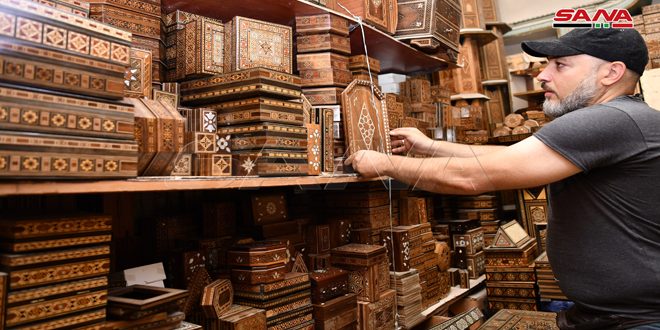Mother-of-pearl marquetry craft is an ancient intricate wood inlay technique which Damascus has perfected for a long time and is renowned for, as it highlights aspects of Damascene heritage, that included turning wood into elegant designs with excellent craftsmanship, and embellishing old Damascene houses and worshipping places, like mosques and churches, with delicate and intricate motifs.
 Wood inlay dates back hundreds of years, as hardly an old Damascene house did not own a mother-of-pearl inlaid furnishing of a sort as a decorative element of the house. Ancient buildings and hotels in Damascus had an architectural style based on the art of marquetry. Qasr al-Athm, A’nbar Office and Beit Nitham are among the most famous Damascene residential places, decorated by inlaid wood and mother of pearl furnishings.
Wood inlay dates back hundreds of years, as hardly an old Damascene house did not own a mother-of-pearl inlaid furnishing of a sort as a decorative element of the house. Ancient buildings and hotels in Damascus had an architectural style based on the art of marquetry. Qasr al-Athm, A’nbar Office and Beit Nitham are among the most famous Damascene residential places, decorated by inlaid wood and mother of pearl furnishings.
At his shop in old Damascus, artisan Hassan al- Harastani displays his various woodwork, saying: “Wood inlay is a craft that depends greatly on the craftsman’s imagination for carving, inlaying and transforming wood into artistically ornamented woodworks. Floral motifs and drawings are used along with geometric shapes such as octagons, squares, hexagons and triangles for the purpose of creating woodwork with traditional ornate carvings. We use certain types of wood including lemonwood, rosewood and beech, dyed mainly in black or green.”
Despite its modesty and simplicity, the shop is filled with old antiques of distinctive oriental pieces. In one of its corners, there are small machines, equipment and tools for wood carving, lathing, inlaying and varnishing, as well as mother of pearl oyster shells, and thin wood panels.
In an adjoining storehouse, there are pieces of oriental furniture, assorted boxes, ornate cabinets and sideboards, game tables and others.
Al-Harastani said that this art has become Syria’s ambassador to most of the countries of the world namely though Syrian expatriates who like to keep a shell inlay wooden piece, from their own country, like a souvenir. This craft, however, has been immensely impacted by the long war. Before that, tourists constituted the major part of our clients who collected heritage pieces. At any rate, there are quite some concerned people who still find our wooden inlay work appealing.
Mother-of-pearl marquetry passes through four stages, starting with designing the wooden structure of the desired piece, and then cutting the shell plaques and pasting them, which is the most labor- and time- intensive stage, according to al-Harastani, because it requires extreme precision, a great attention to detail and an artistic sense.
Afterwards, a shining gloss like substance is added to give the finished product a lovely glow. Finally, cases and boxes are upholstered by cloth inner linings.
He explained that this profession is not valued only for its significant heritage but also because wood inlay is extensively decorative. It is worked into designs of delicate floral arabesques and intricate geometrics to decorate the finest furniture, ceilings, places of worship, home décor, wardrobes, chairs and Qurans stands (hinged wooden panels). The wood inlay technique includes mother of pearl inlaid in carved wood, silver and mother of pearl, in addition to bone and shell, as well as mosaic.
As for the seashell used, al-Harastani mentioned sea and river shells as the two kinds used in wood inlay, adding that currently sea shells are frequently used due to their iridescent beautiful colors. This kind is imported from India, the Philippines and Thailand. The wood used is mostly walnut because it is resilient and easily cut in large panels, in addition to its distinguished red brown color that changes neither color nor quality over time.
Despite its limited production under the current circumstances and the limited number of clients- namely those who are fond of heritage- marquetry has its own character and charm that differ it from many other ancient handicrafts.
Rayan Faouri

